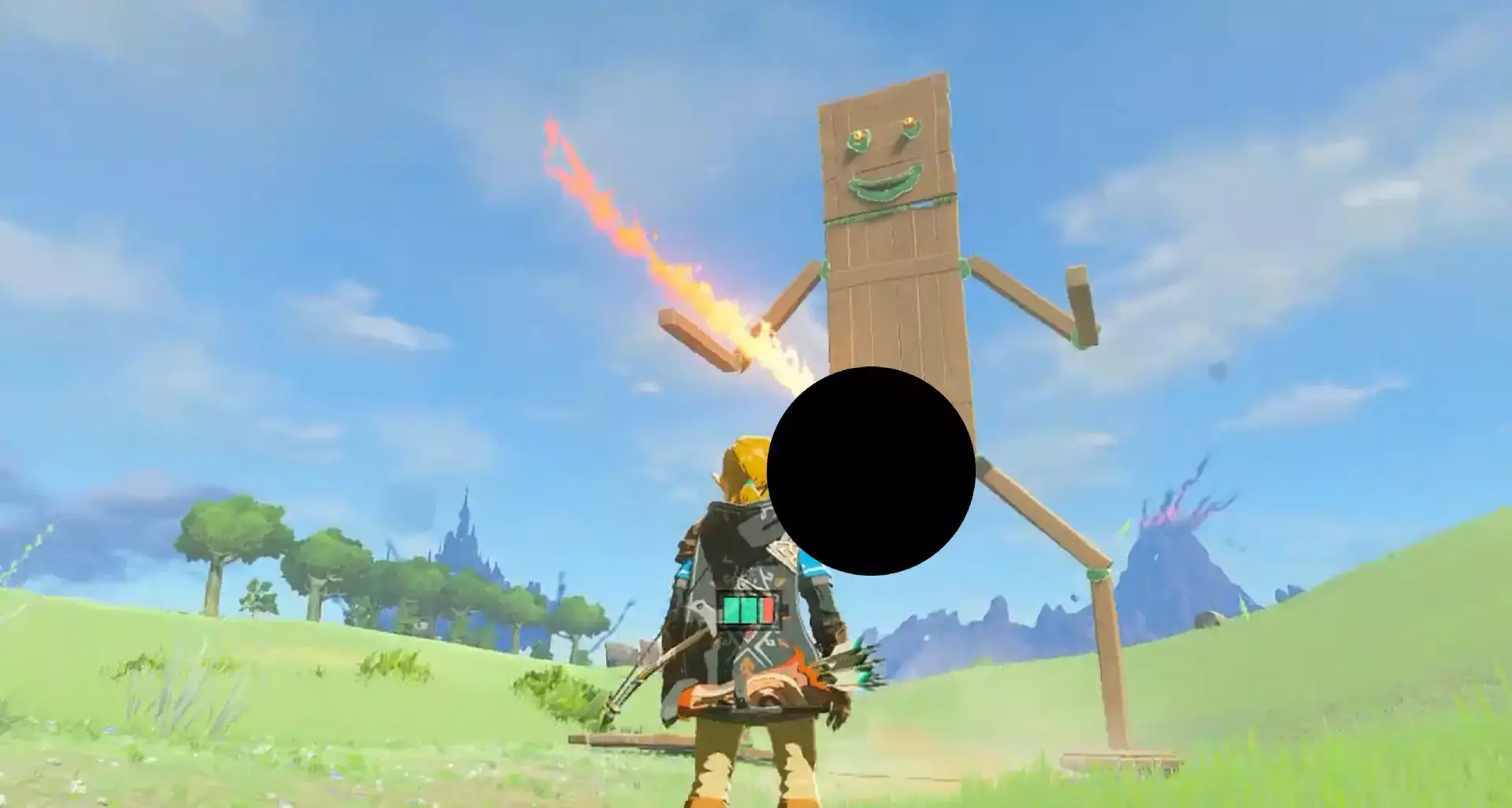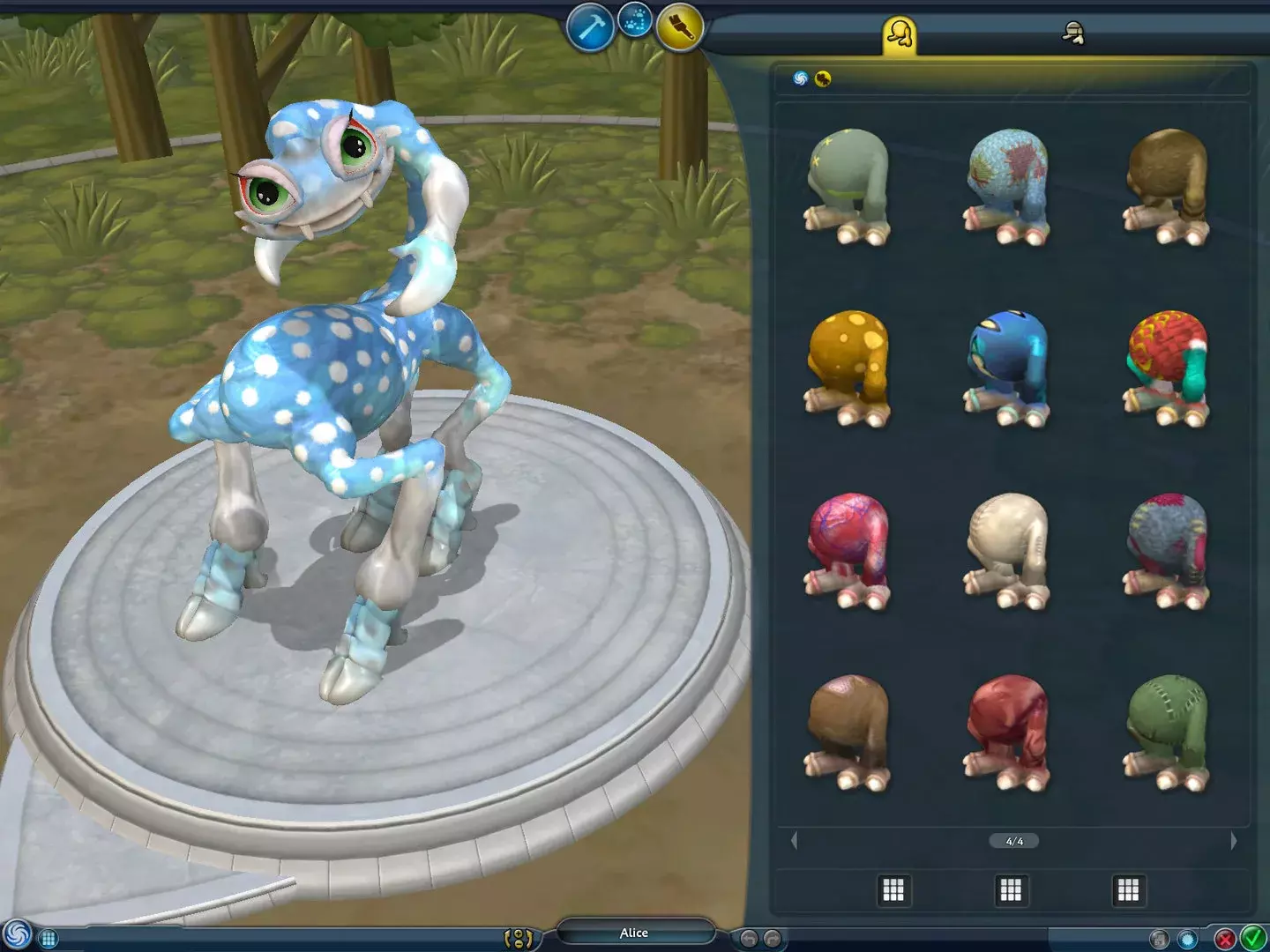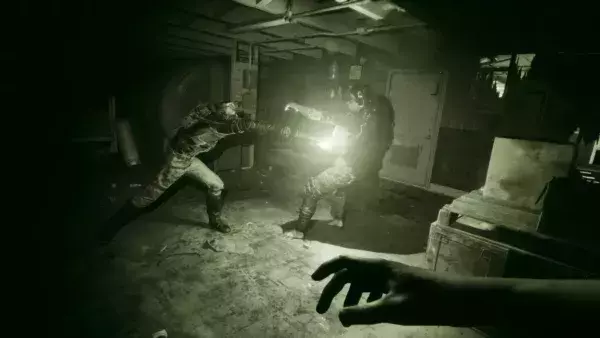
Tears of the Kingdom players have been quick to make and share all kinds of silly, rude (and phallic) clips. And the games industry even has a name for it: Time to Penis…
On 13 May, mischievous Twitter user @ZAKUYA_BOTW tweeted a short clip that, at the time of writing, has received over 30 million views.
The clip is taken from a playthrough of The Legend of Zelda: Tears of the Kingdom, and shows off an example of what can be done with the game’s already famous construction mechanics. Using (among other things) a few bits of wood, a couple of bombs and the game’s new Ultrahand ability, the player has managed to create a gigantic human effigy that would put The Wicker Man to shame.
Then, as Link fires one perfectly-aimed arrow, the tip of the human figure’s phallus ignites, emitting a jet of orange flame. Seconds later, the figure’s bomb-testicles explode, shattering the effigy into a million pieces, and leaving its grinning face – now on fire – skittering to the floor.
新しい神獣 #ゼルダの伝説 #TearsOfTheKingdom #Zelda #NintendoSwitch pic.twitter.com/uBBAc0HWir
— ZAKUYA (@ZAKUYA_BOTW) May 13, 2023
It is, of course, puerile, childish, and hardly the kind of thing Nintendo would want people to be sharing on social media. And, as I subsequently learned from a couple of replies – it’s an example of something called TTP, or Time to Penis.
“In game design,” went one reply (from Splash Damage senior platform engineer Regner Blok-Anderson, no less), “we call this TTP (time to penis) and every feature gets a value.”
Being an innocent-minded sort, I’d never heard of TTP before, and so – having taken a deep breath – I googled the term, and sure enough, it is indeed something discussed in the games industry.
According to knowyourmeme.com, the term has its origins in the development of the 2008 strategy sim, Spore. To quote that website, “Developers at Maxis came up with the metric to measure the amount of time in which a player was able to create a penis using in-game tools.”
The term then leapt to wider attention following a talk at 2009’s Game Developers Conference, where TTP was defined as “the amount of time it will take children to make something rude out of a set of tools they’ve been given.”
Keen to know more, I got in touch with Alex Hutchinson, who – along with the legendary Will Wright and others – was one of Spore’s lead designers back in 2008. So did the term TTP really originate during the development of Spore, and if so, was it just a passing joke or was it a genuine concern among the team?
“Yes, it was a legitimate concern,” Hutchinson told us over Twitter DM. “It was almost the first thing a certain subset of players built, just to see if it would work. And in a game where 100 percent of what you make was automatically shared, then we knew we at least had to think about it.”
While Hutchinson can’t say for sure whether TTP was coined during the making of Spore, he recalls that, “I remember [programmer] Chris Hecker using it a lot when we were discussing the editors and the creation tools. So I wouldn’t be surprised!”

Spore’s tools allowed for the creation of all kinds of strange (and potentially rude-looking) creatures. Credit: Maxis/EA.
Spore arrived at a significant moment in web history. While opportunities for players to create and share in-game content had already existed for years, the advent of web 2.0 made it easier than ever for people to spread the fruits of their labour with other users in a matter of seconds. Spore, in particular, allowed players to share their creations directly to YouTube – meaning that a mischievous user could create something rude-looking and get a clip of it online almost instantly. The game’s TTP value was, therefore, tiny – and all developer Maxis could do to combat it was to monitor user-generated content and hope that other players would flag anything else they saw as inappropriate.
“There is absolutely nothing that can stop it,” says Hutchinson. “Almost anything in the right light or at the right angle can look like a penis. A stack of boxes. Anything. The execs were terrified but you can’t create a filter, you can’t use templates, nothing. In the end we realised we just needed a way to ban and report. Like pornography, people know it when they see it, so they can do it by hand.”
As Tears of the Kingdom has shown, the combination of creative tools and social media can provide all kinds of opportunities for mischief. Given the chance, players will find all kinds of ways to draw or write rude things in-game – just ask Rich D May. A veteran programmer at Rebellion, he’s worked on the likes of Battlezone, Rogue Trooper and Sniper Elite V2.
“I’m struggling to remember where I first heard the term [TTP],” May tells us, “but it always comes up whenever there’s discussion of user-generated content. I remember having to consider how many bullet hole decals you would allow the player to create. Because, if you’re firing your machine gun at a wall, within a few seconds you’re writing your name or drawing something… inappropriate. It’s sort of an inevitability – if you give the player the ability to draw something, then it’ll almost certainly happen in a very short amount of time.”
Hutchinson found similar situations in the years after he worked on Spore. “We put a deformable snow into Assassin’s Creed 3,” he recalls, “and the first thing the play testers did was walk in the shape of a penis. All we could do was make it time out so it was a temporary penis. When we let you design your masks for Army of Two: The 40th Day, everyone was an instant dick head.”
For Nintendo, which has long prided itself on its family-friendly reputation, the possibility of people making and sharing rude things in Tears of the Kingdom must have come up in board meetings. It’s interesting to think that, once upon a time, Nintendo of America was incredibly jumpy when it came to religious imagery; in 2023, players are cheerfully sharing in-game Zelda footage of crucified Koroks. To date, Nintendo doesn’t appear to have taken steps to have these clips taken down.
Do you think the TOTK devs foresaw players crucifying koroks or were the QA testers not as blood thirsty as the average nintendo player pic.twitter.com/BuJp2jeBQP
— Buns ✨️Reconnect✨️ (@SuperButterBuns) May 15, 2023
“I do wonder whether [Nintendo] had that conversation quite early in the project,” says May of Tears of the Kingdom, “because Breath of the Wild gave you some opportunities to make things, but nothing like this. And there are games out there, I guess, with similar building mechanisms, so they would have known right at the beginning. You can imagine executives at Nintendo saying, ‘Can you ensure this won’t happen?’ and all the answers would have been, ‘No!’”
Ultimately, Nintendo must have made the not unreasonable decision that it’s better to let people’s creativity run free rather than try to stifle it. Besides, preventing players from, say, sticking some pieces of wood together to make a human effigy with a giant, flaming phallus would be almost impossible. But given that artificial intelligence is being sold to us as the cure for all problems of late, could it be used to monitor players’ behaviour in future games? Could AI one day render TTP obsolete?
“I think it’s about the only way it could ever work,” says May. “The big worry is what you see with Facebook and other platforms, where they’ve tried to filter out adult content, but things like people breastfeeding gets flagged. Oh my God – a nipple! There’s always the risk of misclassification.”
“That should be the new Turing test,” Hutchinson jokes when we asked whether AI could help eliminate TTP. “People [can differentiate] between a stack of boxes and a penis, but they can’t tell you why. If the AI can do it, turn it off immediately.”
Barring some miraculous breakthrough in machine learning, then, TTP is here to say – and by extension, so are those silly videos of exploding balls and crucified Koroks. And maybe that’s no bad thing; as Rich May points out, it’s a part of our nature, and as old as the human species itself. “I was reading about a cave painting discovered somewhere,” he says, “and 5,000 years ago someone had drawn a phallus on the wall. It’s like, ‘yep – nothing’s changed…’”





